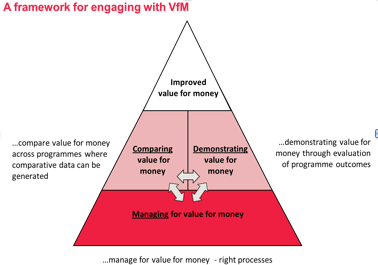Exciting New NGO VfM Resources from BOND
Improving value for money is not about delivering activities at the lowest cost or creating the outcomes that are easiest to measure and monetise, rx we conclude in a new paper by Bond, the membership body for UK development NGOs.
The paper moves away from looking at value for money as a donor imposition and instead frames it as an opportunity for NGOs to improve the consistency and robustness of how they assess, demonstrate and strengthen the effectiveness of their work.
Developing a new framework for value for money
Building on examples drawn from the current practice of UK development NGOs, the paper presents a framework to help NGOs navigate the value for money agenda and identify which approaches and methods are best suited to their needs. The framework identifies three areas that UK NGOs should focus on to deliver and improve value for money:
- the systems and processes in place for managing value for money
- the approaches they use to compare value for money between activities
- the use of evaluations to demonstrate value for money
There is no one size fits all approach, as the range of different methodologies being used across the sector shows.
While the language of value for money may be new, many of the methods and approaches used to realise it are not. Transparent procurement, monitoring expenditure, avoiding corruption, should already be very familiar to many NGOs.
Do we really need econometric modelling?
Perhaps the newest element of the value for money agenda (and the one that most NGOs are most wary of) is the use and promotion of econometric modelling and methods such as Cost Benefit Analysis or Social Return on Investment studies as a way of demonstrating value for money. In the paper we are clear that while these methods may work in some situations, they are not suited to every context and there are other similarly robust ways of demonstrating value for money which do not require monetisation of outcomes.
For example, an evaluation of an NGO’s programmes which combines high quality quantitative and qualitative evidence of outcomes and impact with strong evidence of economy and efficiency on the cost side can also provide a powerful evidence base for demonstrating value for money. It is important that we do not overcomplicate what it means to demonstrate value for money; ultimately it should be about NGOs explaining their cost, robustly describing their results and justifying the relationship between the two. You don’t need an economic model to do this well.
Putting beneficiaries at the heart of value for money
The paper also argues that listening to the voices and focussing on the priorities of beneficiaries is key to achieving value for money. The practical resource on incorporating value for money into the programme cycle which accompanies the Bond paper looks at how beneficiary participation throughout the programme cycle is crucial for building a strong case for value for money. This is in line with the Independent Commission for Aid Impact’s new report on value for money which argues for value for money to be a balance between economy, efficiency, effectiveness and equity. Equity, assuring that benefits are distributed fairly, speaks to the central place of poor and marginalised beneficiaries in the value for money debate.
Join the debate
We hope that this paper generates discussion and is useful to NGOs and others in shaping the way they approach value for money. We welcome your feedback and experiences of using the framework and tool.
Comments are closed.